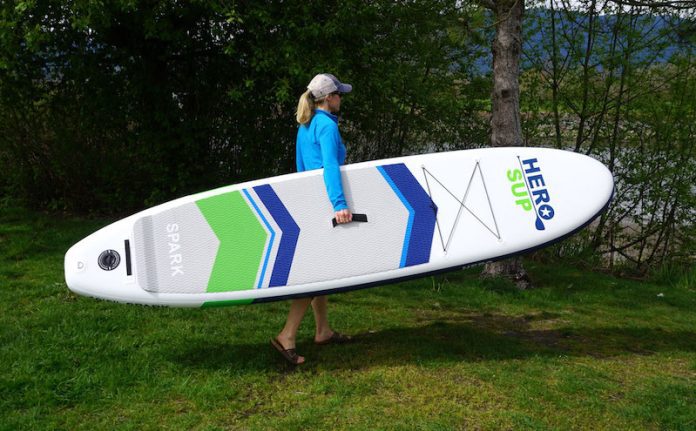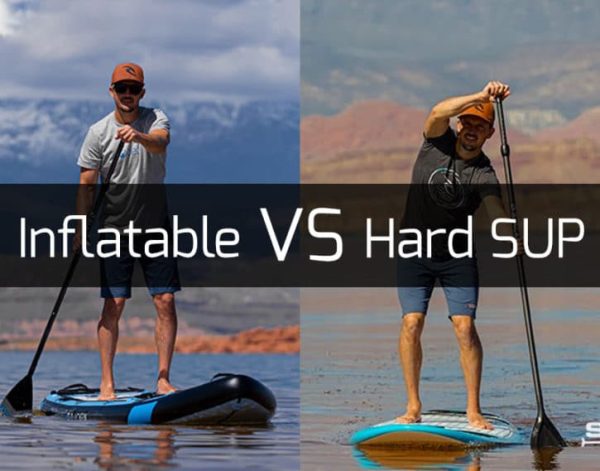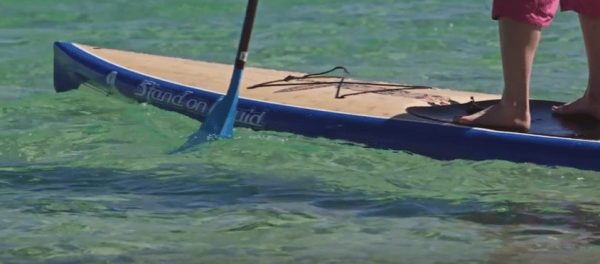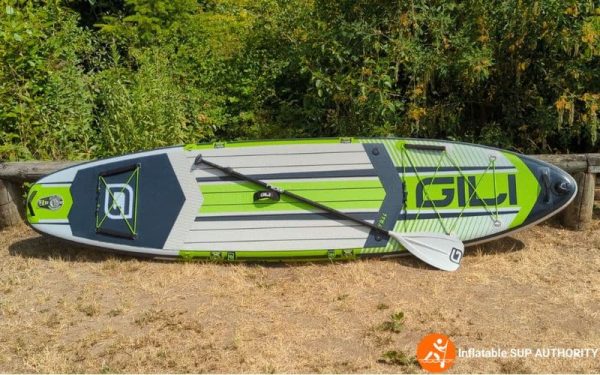In our quest for the perfect stand-up paddleboard (SUP), we often ponder the age-old question: Is a lighter SUP better?
As avid paddlers, we understand the desire for a board that effortlessly glides across the water, but does lighter always equate to better performance?
Join us as we explore the pros and cons of lighter SUPs and unravel the mystery behind finding the perfect balance between weight and functionality.
This image is the property of www.supboardguide.com.
Benefits of a Lighter SUP
Regarding stand-up paddleboarding (SUP), the weight of your board can significantly impact your overall experience. Opting for a lighter SUP can offer a range of benefits that enhance your enjoyment on the water. From improved maneuverability to more accessible transportation and enhanced performance, a lighter SUP can make a difference.
Improved Maneuverability
One of the key benefits of a lighter SUP is improved maneuverability. The lighter weight allows for easier turning, making navigating through tight spaces or maneuvering around obstacles easier.
This can be particularly advantageous when paddling in crowded areas or navigating narrow waterways. Whether you are a beginner learning the basics or an experienced paddler looking to take your skills to the next level, a lighter SUP can help you effortlessly glide through the water with greater control.
Easier Transport
Transporting a bulky and heavy SUP can be daunting, especially if you don’t have easy access to the water. A lighter SUP makes transportation much more manageable, particularly if you need to carry it for long distances or load it onto a vehicle.
It’s easier to lift, carry, and handle a lighter board, allowing you to spend more time enjoying the water and less time struggling with logistics. Whether you’re heading out on a road trip or need to shuttle your board from your car to the beach, a lighter SUP can simplify the process and make it more convenient.
Enhanced Performance
A lighter SUP can also improve your overall performance on the water. With less weight to drag through the water, you’ll experience less resistance and greater efficiency in your paddling strokes.
This means you can paddle faster and cover more distance with less effort. Whether participating in a SUP race or exploring new waterways, a lighter board can help you achieve better times and more enjoyable paddling experiences. It allows for a smoother glide and less fatigue, enabling you to paddle longer distances and easily explore new places.
Reduced Fatigue
SUPing for extended periods can be physically demanding, especially if you’re lugging around a heavy board. Opting for a lighter SUP can significantly reduce fatigue and make paddling sessions more enjoyable.
With less weight, your muscles won’t tire as quickly, ensuring you can stay out on the water for more extended periods without feeling exhausted. Whether paddling for fitness or enjoying a leisurely day on the water, a lighter SUP can make your experience more comfortable and help you avoid unnecessary strain on your body.
Factors Affecting SUP Weight
Now that we understand the benefits of a lighter SUP let’s dive into the various factors that can affect the weight of a paddleboard. By understanding these factors, you can make an informed decision when choosing the suitable SUP for your needs.
Materials
The choice of materials used in constructing an SUP plays a significant role in determining its weight. Solid SUPs are commonly made from fiberglass, carbon fiber, wood, or plastic.
Each material has its weight characteristics, with lighter materials such as carbon fiber offering a significant weight reduction compared to heavier options like fiberglass. In recent years, inflatable SUPs have gained popularity due to their lightweight nature, making them an attractive option for those seeking a lighter board.
Construction Methods
Not only do the materials affect the weight of a SUP, but the construction methods used also play a role. Different manufacturing techniques can result in variations in weight. For example, a hand-shaped board might be lighter than one mass-produced using a mold. Similarly, the design and placement of reinforcement layers within the board can also impact its weight. Consideration of construction methods is crucial when seeking a lighter SUP.
Thickness
The thickness of the SUP can contribute to its overall weight. Thicker boards tend to be more stable, which can be advantageous for beginners or those looking for a more relaxed paddling experience.
However, thicker boards generally weigh more, as more material is used in their construction. Thinner boards, on the other hand, are generally lighter but may sacrifice a bit of stability. Finding the right balance between thickness and weight is essential, depending on your skill level and intended use.
Size and Shape
The size and shape of the SUP are also factors that affect its weight. Larger boards tend to be heavier due to the increased surface area, while smaller boards are generally lighter. Specific shapes, such as more comprehensive and rounder noses, can add weight. It’s essential to consider the size and shape of the SUP to ensure it aligns with your skill level, intended use, and desired weight.
Different Types of SUPs and Their Weight
SUPs come in various types, each tailored to specific activities and preferences. Let’s explore the different types of SUPs and their respective weights.
All-Round SUPs
All-round SUPs are versatile boards for various recreational activities, including flatwater paddling, yoga, and small waves. They are often broader and more stable, making them suitable for beginners or those looking for a relaxed paddle. Generally, all-round SUPs range from 9 to 12 feet long and can weigh between 20 to 35 pounds (9 to 16 kilograms). The weight will vary depending on materials, construction methods, and size.
Touring SUPs
Touring SUPs are designed for longer paddling adventures, focusing on speed and efficiency. These boards are typically longer and narrower than all-around SUPs, allowing for more excellent glide and faster speeds. Touring SUPs can range from 11 to 14 feet long and weigh between 25 to 35 pounds (11 to 16 kilograms). The weight will depend on materials, construction methods, and size.
Race SUPs
Race SUPs are built for speed and are specifically designed for competitive racing. These boards are typically longer, narrower, and have a more streamlined shape to optimize performance. Race SUPs can range from 12 to 14 feet in length and weigh between 20 to 30 pounds (9 to 14 kilograms). Again, the weight will vary depending on materials, construction methods, and size.
Inflatable SUPs
Inflatable SUPs have gained popularity recently due to their portability and easy storage. These boards are made from durable PVC materials and can be inflated and deflated for easy transportation. Inflatable SUPs come in various sizes and styles, ranging from all-round to touring and even racing options. While they tend to be slightly heavier than their solid counterparts, weighing between 20 to 30 pounds (9 to 14 kilograms), they offer the convenience of easy transport and storage.
Choosing the Right SUP Weight for Your Needs
Choosing the right SUP weight for your needs requires careful consideration of several factors. Let’s explore these factors to help you make an informed decision.
Skill Level
Your skill level is an essential factor to consider when choosing the right SUP weight. Beginners may benefit from a slightly heavier board that offers more stability, making finding their balance easier and building confidence on the water. Intermediate paddlers who have mastered the basics and are looking to progress their skills may opt for a lighter board to improve maneuverability and performance. Advanced paddlers who are confident in their abilities and prioritize speed and agility may prefer the lightest board possible for optimal performance.
Intended Use
Considering your intended use is crucial when selecting the right SUP weight. If you plan to primarily paddle on calm lakes and rivers or engage in leisurely activities like yoga or fishing, a slightly heavier board with more stability may be suitable. On the other hand, if you’re planning on exploring large bodies of water or participating in racing events, a lighter board that prioritizes speed and efficiency would be more appropriate. Consider the most frequent activities you’ll engage in and choose a SUP weight that aligns with those pursuits.
Weight Capacity
Another factor to consider is your weight capacity. SUPs have a recommended maximum weight limit, and exceeding this limit can negatively affect performance, stability, and safety. Be sure to choose a SUP weight that accommodates your weight and any additional gear or accessories you plan to bring along on your paddling adventures. Choosing a board with a higher weight capacity is always better than pushing the limits, as this ensures optimal performance and stability.
Storage and Transport
The ease of storage and transport should also be considered when choosing the right SUP weight. A lighter SUP would be more suitable if you have limited storage space or frequently need to transport your board. This is particularly important if you rely on public transportation or carry your board long distances to access the water. On the other hand, if storage space and transportation are not significant concerns, you may have more flexibility in choosing a slightly heavier board that offers other desirable features.
This image is the property of www.supboardguide.com.
Trade-Offs of Lighter SUPs
While lighter SUPs offer a range of benefits, knowing the potential trade-offs associated with choosing a lighter board is essential.
Durability
Lighter SUPs, especially those made from lightweight materials, may be more prone to damage and wear and tear. They may not withstand impact or rough handling, and heavier, more durable boards. Handling a lighter SUP carefully is crucial to avoid unnecessary damage and ensure longevity. This might involve being more cautious when launching and landing, avoiding sharp objects and rocky shorelines, and investing in protective measures such as board bags or deck pads to minimize the risk of damage.
Stability
Lighter SUPs are often designed to prioritize maneuverability and performance over stability. While this can be advantageous for experienced paddlers, it may pose a challenge for beginners or those who prioritize stability in their paddling experience. Remember that lighter boards may feel less stable, especially in rougher water conditions or when attempting more advanced maneuvers. Assessing your skill level and comfort with instability is vital before opting for a lighter SUP.
Price
Generally, lighter SUPs made from high-quality materials are more expensive than heavier ones. Materials such as carbon fiber or lightweight composites can increase the cost of a SUP. Additionally, boards incorporating advanced construction methods may require more intricate manufacturing processes, contributing to a higher price tag. It’s essential to consider your budget and weigh the benefits against the cost when deciding on the right SUP weight for your needs.
Ideal SUP Weight Ranges for Different Users
While there is no one-size-fits-all answer to the ideal SUP weight, here are some general guidelines based on user preferences and skill levels:
Beginners
A slightly heavier SUP range of 25 to 35 pounds (11 to 16 kilograms) is generally recommended for beginners. These boards offer more stability, making finding balance easier and building confidence on the water. Opting for a broader and longer all-around SUP can provide the stability needed for beginners to learn the basics and develop their paddling skills.
Intermediate Paddlers
Intermediate paddlers who have gained proficiency and are looking to progress their skills may opt for a lighter board of 20 to 30 pounds (9 to 14 kilograms). These boards offer improved maneuverability and performance, allowing intermediate paddlers to explore more dynamic water conditions and refine their paddling techniques.
Advanced Paddlers
Advanced paddlers prioritizing speed, agility, and performance may seek the lightest SUPs available. Depending on construction and materials, these boards can range from 20 to 25 pounds (9 to 11 kilograms). Advanced paddlers often require highly responsive boards that offer maximum efficiency to ensure they can push their limits and achieve their highest potential.
Surfing Enthusiasts
For those who enjoy SUP surfing, weight becomes even more critical. Surfing SUPs are typically shorter and have specific design features to enhance wave maneuverability. Lighter SUPs in the range of 15 to 20 pounds (7 to 9 kilograms) are often preferred by experienced surfers, as they offer the agility and responsiveness needed to catch and ride waves effectively.
This image is the property of cdn.shopify.com.
Tips for Maintaining a Light SUP
Following proper maintenance practices is essential to ensure your light SUP remains in optimal condition and provides years of enjoyment. Here are some tips for maintaining a light SUP:
Proper Storage
When storing your SUP, keeping it in a dry and secure location is crucial. Avoid storing it in direct sunlight or extreme temperatures, as this can cause damage to the materials. Store it indoors, such as in a garage or storage shed, to protect it from the elements. If you have limited space indoors, consider investing in a board rack or storage system designed explicitly for SUPs.
Regular Cleaning
After each use, rinse your SUP with fresh water to remove any saltwater, sand, or debris that may have accumulated. Use a gentle detergent or SUP-specific cleaner to remove stubborn stains or dirt. Avoid using abrasive materials or harsh chemicals that could damage the board’s surface. Regular cleaning helps prevent the buildup of dirt and grime, ensuring your SUP remains in good condition.
Avoiding Impact and Extreme Temperatures
While lighter SUPs can offer improved maneuverability, they may be more susceptible to damage from impact. Be mindful of potential hazards in the water, such as rocks, debris, or shallow areas, to avoid collisions that could cause dents or punctures. Additionally, avoid exposing your SUP to extreme temperatures, as this can weaken the materials and potentially lead to warping or cracking.
Repairing Minor Damages
Over time, minor damages such as scratches or dings may occur on your SUP. It’s essential to address these issues promptly to prevent further damage. Invest in a SUP repair kit, which typically includes epoxy resin and fiberglass cloth, to patch any small cracks or holes. If you’re unsure about the repair process, it’s always best to consult a professional to ensure the best results and maintain the integrity of your SUP.
Conclusion
In conclusion, choosing a lighter SUP can offer a range of benefits for paddlers of all skill levels. From improved maneuverability and more accessible transport to enhanced performance and reduced fatigue, a lighter board can enhance your overall paddling experience.
Factors such as materials, construction methods, thickness, size, and shape all play a role in determining the weight of an SUP. When selecting the right SUP weight, it’s essential to consider your skill level, intended use, weight capacity, and storage requirements. While lighter SUPs offer advantages, it’s essential to be aware of potential trade-offs, such as durability, stability, and price.
Proper maintenance practices, such as storing your SUP correctly, regular cleaning, and avoiding impact and extreme temperatures, will ensure your light SUP remains in optimal condition for years.
This image is the property of www.inflatablesupauthority.com.









































